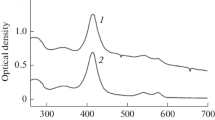Abstract
Phallolysin, the high-molecular weight hemolysin fromAmanita phalloides, was present in high activity in each of 42 samples ofA. phalloides. The toadstools were collected in 19 different locations during a period of 4 years.
Aqueous extracts of 12 furtherAmanita species of differing origin were tested for hemolytic activity. Several samples of each species — altogether 99 — were tested on rabbit and human erythrocytes.
Hemolysins were present inA. muscaria, A. gemmata, A. verna, A. citrina, A. porphyria, A. spissa, A. echinocephala and invariably and in high activity inA. rubescens.
According to the present results and to unpublished observations, the hemolysin ofA. rubescens differed from Phallolysin ofA. phalloides.
The extracts ofA. muscaria also produced agglutination of red blood cells.
Zusammenfassung
Phallolysin, das hochmolekulare Hämolysin ausAmanita phalloides, wurde in 42 verschiedenen Chargen grüner Knollenblätterpilze konstant und in hoher Aktivität nachgewiesen. Die Pilze waren an 19 verschiedenen Fundorten in 4 Jahren gesammelt worden.
Wäßrige Extrakte von 12 weiterenAmanita-Arten wurden an Kaninchen-und menschlichen Erythrocyten auf hämolytische Aktivität geprüft. Wenn möglich wurden von jeder Art mehrere Chargen — insgesamt 99 — von verschiedenen Fundorten untersucht.
Hämolysine wurden nachgewiesen inA. muscaria, A. gemmata, A. verna, A. citrina, A. porphyria, A. spissa, A. echinocephala und — konstant und in hoher Aktivität — inA. rubescens.
Aus den vorliegenden und weiteren, noch unveröffentlichten Befunden ging hervor, daß das Hämolysin ausA. rubescens mit Phallolysin ausA. phalloides nicht identisch ist.
A. muscaria-Extrakt führte zusätzlich zur Agglutination der Erythrocyten.
Similar content being viewed by others
Literatur
Abel, J. J., Ford, W. W.: On the poisons ofAmanita phalloides. J. biol. Chem.2, 273–288 (1907).
Abel, J. J., Ford, W. W.: Further observations on the poisons ofAmanita phalloides. Naunyn-Schmiedebergs Arch. exp. Path. Pharmak., Suppl. Band Schmiedeberg-Festschrift, 8–15 (1908).
Ford, W. W.: (1) The toxins and antitoxins of poisonous mushrooms (Amanita phalloides). J. infect. Dis.3, 191–224 (1906).
Ford, W. W.: (2) The toxicological constitution ofAmanita phalloides. J. exp. Med.8, 437–450 (1906).
Ford, W. W.: On the presence of hemolytic substances in edible fungi. J. infect. Dis.4, 434–439 (1907).
Ford, W. W.: The distribution of poisons in the amanitas. J. Pharmacol. exp. Ther.1, 275–287 (1909).
Kobert, R.: Über Pilzvergiftung. St. Petersb. med. Wschr.16, 471–474 (1891).
Kobert, R.: Lehrbuch der Intoxikationen,1. Aufl., S. 457 ff. Stuttgart: F. Enke 1893.
Kobert, R.: Lehrbuch der Intoxikationen, 2. Aufl., S. 614 ff., 763. Stuttgart: F. Enke 1906.
Kobert, R.: Sitzungsber. Naturforsch. Ges. Rostock, 1899, 26, zit. nach Abel, J. J., Ford, W. W. (1907).
Michael, E., Hennig, B.: Handbuch für Pilzfreunde. I. Die wichtigsten und hdufigsten Pilze. Jena: G. Fischer 1968.
Michael, E., Hennig, B.: Handbuch für Pilzfreunde. III. Hellbldttler und Leitstlinge. Jena: G. Fischer 1964.
Moser, M.: Basidiomyceten, II. Teil. Die Röhrlinge, Blätter- und Bauchpilze. In: Gams, H., Kleine Kryptogamenflora, II b/2. Stuttgart: G. Fischer 1967.
Raab, H. A., Renz, J.: Beiträge zur Kenntnis der Giftstoffe derAmanita-Arten. Hoppe-Seylers Z. physiol. Chem.216, 224–228 (1933).
Seeger, R., Scharrer, H.: Purification and characterization of phalloides hemolysin, a high molecular weight toxin from Amanita phalloides. Naunyn-Schmiedebergs Arch. Pharmacol.274, R. 106 (1972).
Seeger, R.: Nachweis, Isolierung und Charakterisierung von Phallolysin, einem toxischen, hhmolytisch wirkenden Protein aus Amanita phalloides. Habilitationsschrift, Würzburg 1972.
Seeger, R., Wiedmann, R.: Zum Vorkommen von Hämolysinen und Agglutininen in höheren Pilzen (Basidiomyceten). Untersuchungen an 293 Arten. Arch. Toxikol.29, 189–217 (1972).
Seibert, J.: Beiträge zur Toxikologie der Amanita phalloides. Med. Diss., Würzburg 1893.
Smith, A. H.: The mushroom hunter's field guide, p. 138. Ann Arbor: 1958.
Tyler, V. E., Jr., Benedict, R. G., Brady, L. R., Robbers, J. E.: Occurence of amanita toxins in american collections of deadly amanitas. J. pharm. Sci.55, 590–593 (1966).
Author information
Authors and Affiliations
Additional information
Mit Unterstützung der Deutschen Forschungsgemeinschaft.
Rights and permissions
About this article
Cite this article
Seeger, R., Kraus, H. & Wiedmann, R. Zum Vorkommen von Hämolysinen in Pilzen der GattungAmanita . Arch Toxicol 30, 215–226 (1973). https://doi.org/10.1007/BF02426045
Received:
Issue Date:
DOI: https://doi.org/10.1007/BF02426045




